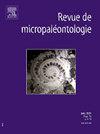Recent planktonic foraminifera population and size response to Eastern Mediterranean hydrography
Abstract
The eastern Mediterranean Sea is a partially isolated sea where excess evaporation over precipitation or riverine discharge results in large north to south gradients in temperature and salinity. Eastern Mediterranean Sea surface sediment samples from 28 locations spanning from the North Aegean to the Levantine Sea have been examined for recent planktonic foraminiferal distribution. In addition to determining the relative abundance of 12 species that have been identified, the average intraspecific size along with the size of the overall faunal pattern was also examined. The quantitative analysis performed on >125 μm fraction reveals pronounced and complex changes in planktonic foraminiferal assemblages that do not parallel the intraspecific size variation and sea surface temperature (SST). On the contrary, foraminifera most of the times are slightly larger in the colder and fresher North Aegean and become progressively smaller toward the warmer Levantine Sea. We conclude that the relationship between planktonic foraminifera shell size and abundance or SST are either absent or weaker than previously reported for other regions and that in E. Mediterranean assemblages size may be mainly related to nutrient availability.

 求助内容:
求助内容: 应助结果提醒方式:
应助结果提醒方式:


